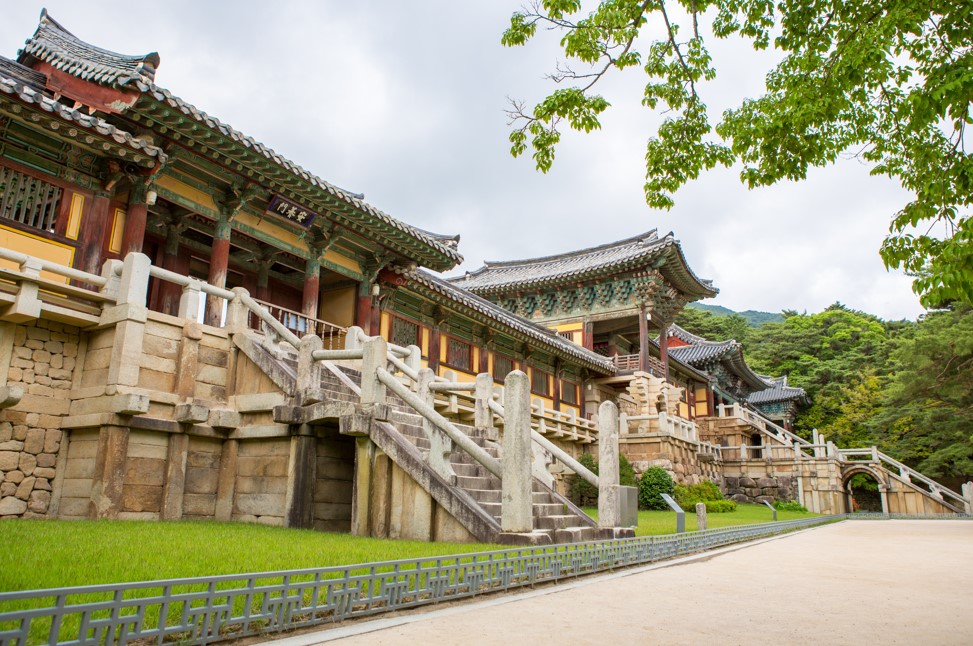Exploring Korea’s temples offers a glimpse into the country’s profound Buddhist heritage, tranquil landscapes, and stunning architecture. Here is a list of the top 5 temples that are well worth visiting for anyone interested in history, spirituality, or simply looking for a peaceful retreat.

Bulguksa Temple is a symbolic site that reflects the beauty of Buddhist art and philosophy in Korea. It offers an immersive glimpse into Silla-era culture and traditional Korean architecture, making it a must-visit destination for foreigners exploring Korea’s rich heritage.
Location: 385 Bulguk-ro, Gyeongju, Gyeongsangbuk-do, South Korea
History:
Bulguksa Temple, built during the 8th century in the Silla Dynasty, is one of Korea’s most iconic Buddhist temples. Construction began in 751 AD under the guidance of Kim Dae-seong to honor his parents and accumulate merit for both his past and present lives. It was completed in 774 AD. Over the centuries, the temple went through multiple restorations during the Goryeo and Joseon Dynasties. In the 1970s, a major restoration project revived its original splendor.
UNESCO World Heritage Site:
In 1995, Bulguksa was designated a UNESCO World Heritage Site along with the nearby Seokguram Grotto. It is renowned for the perfect harmony of architecture, sculpture, and painting.
Main Highlights
- Daeungjeon Hall
- The main prayer hall of Bulguksa, enshrining a statue of the Buddha, Shakyamuni.
- Inside, visitors can admire the intricate wooden sculptures and vibrant dancheong (traditional Korean painting on wood).
- Dabotap and Seokgatap Pagodas
- Dabotap Pagoda: Known for its complex carvings, symbolizing the eternal truth of Buddhism.
- Seokgatap Pagoda: A more minimalist and elegant design representing the ideals of Buddhism.
- Both pagodas stand side-by-side in the temple courtyard, showcasing two distinct yet harmonious styles of Korean Buddhist architecture.
- Cheongungyo and Baegungyo Bridges
- These twin staircases symbolize the path leading to the heavenly realm (Bulguk).
- They exemplify the craftsmanship and aesthetic sophistication of the Silla period.
- Yeonhwagyo and Chilbogyo Bridges
- These smaller bridges lead to the Hall of Paradise, symbolizing the journey toward enlightenment.
- They feature lotus motifs, representing purity and spiritual awakening.
Key Attractions of Bulguksa
- Architectural Harmony: Bulguksa embodies the perfect fusion of Buddhist philosophy and artistic design from the Silla era. The combination of wooden structures and stone architecture creates a unique aesthetic appeal.
- Integration with Nature: Situated on the slopes of Mount Toham, Bulguksa offers scenic views throughout the year—cherry blossoms in spring, lush greenery in summer, colorful autumn leaves, and serene snowy landscapes in winter.
- Temple Stay Programs: Bulguksa offers temple stay programs where participants, including foreigners, can experience daily Buddhist practices such as meditation and tea ceremonies, providing a peaceful retreat from the busy world.
Tips for Visitors
- Check Operating Hours: The opening hours may vary depending on the season, so it is advisable to check in advance.
- Explore Gyeongju’s Historic Sites: After visiting Bulguksa, explore nearby attractions like Seokguram Grotto, Cheomseongdae Observatory, and Donggung Palace and Wolji Pond.
- Transportation: Bulguksa is easily accessible by bus or taxi from downtown Gyeongju, and tour buses frequently operate along this route.
